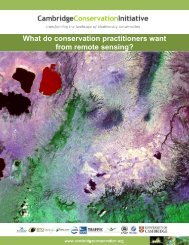CONSERVING BIODIVERSITY & DELIVERING ECOSYSTEM SERVICES
conserving biodiversity & delivering ecosystem services
conserving biodiversity & delivering ecosystem services
Create successful ePaper yourself
Turn your PDF publications into a flip-book with our unique Google optimized e-Paper software.
Supporting<br />
Provisioning<br />
Maintenance of<br />
genetic diversity<br />
Cultivated<br />
food<br />
Harvested<br />
wild food<br />
Raw materials<br />
Natural medicines<br />
Ecosystems are the source of genetic diversity from which a variety of commercial<br />
species can be developed. In Nepal, genetic diversity of crops increases production<br />
and decreases susceptability to pests and climate variation.<br />
In Nepal, the basic cereal crop on which almost all of the population relies is rice, a<br />
cultivated food. There are also over 440 species harvested as wild foods, including<br />
mushrooms and edible ferns.<br />
Timber (a fibre) and fuelwood (an energy source) are hugely important for the<br />
Nepali rural population. The Himalayan Giant Nettle is widely used throughout the<br />
mountainous regions of Nepal as a source of fibre (puwa) for weaving ropes, thread,<br />
porter’s tumplines, mats, sacks, and bhangra (traditional Gurung clothing).<br />
Many communities use natural medicines to treat ailments. Tibetan natural medicine<br />
practitioners called ‘amchis’ and their medical system is commonly practiced in the<br />
mountainous regions of Nepal.<br />
Water flows<br />
Water is vital to sustain life, and is needed for domestic use, drinking and irrigation.<br />
Due to its position in the Himalayas, the mountains of Nepal produce important water<br />
flows for the country and beyond.<br />
Local climate and air<br />
quality regulation<br />
Global climate<br />
regulation<br />
Ecosystems can contribute to regulating local climatic conditions. Nepal’s forests<br />
provide shade and influence rainfall patterns. The wetlands at Koshi Tappu Wildlife<br />
Reserve moderate the local climate by absorbing heat by day and releasing heat at night,<br />
as well as by removing pollutants.<br />
Forests contribute to regulating the global climate through sequestration of<br />
greenhouse gases (CO 2 , NO 2 , CH 4 ) and storage of carbon. In Nepal, over 40% of the area<br />
is forested and so the country makes a major contribution to this important service.<br />
Regulating<br />
Water purification<br />
and waste treatment<br />
Erosion control<br />
Reducing the impact<br />
of weather events<br />
Biological control<br />
Good water quality as a result of natural water purification processes provides safe<br />
drinking water and waste treatment. This is important in maintaining healthy<br />
ecosystems, protecting species and human health.<br />
Forests can help to prevent or control movement of materials from a surface to<br />
another location as a result of wind or water. Although erosion is often a natural<br />
process and can also have benefits, there is evidence across many hill slopes in Nepal that<br />
erosion is leading to water pollution and soil loss.<br />
Ecosystems can help to buffer against negative impacts from weather events and<br />
can help people adapt to the impacts of climate variability and change, e.g. by<br />
providing protection from storms and flooding. The forested Churia hills help to protect<br />
the lowland areas from flooding.<br />
Regulation of pests and vector-borne diseases is an important benefit that we take<br />
for granted. In Nepal, waste disposal by vultures helps to reduce populations of pests<br />
and reduces the risk of diseases spreading.<br />
Cultural<br />
Nature-based<br />
recreation/ tourism<br />
Aesthetic benefits /<br />
inspiration / mental<br />
health<br />
Spiritual / religious<br />
experience<br />
Nepal is a popular tourism destination for birdwatching, wildlife safaris, rafting and<br />
trekking, and this tourism is an important source of national and local income. Koshi<br />
Tappu Wildlife Reserve is a popular destination for birdwatchers while Chitwan and Bardia<br />
National Parks are more famous for large mammals like the Indian Rhinoceros and Tiger.<br />
Ecosystems can provide aesthetic beauty and mental / intellectual stimulation that<br />
lift the human spirit. The beauty of Phoksundo Lake in Shey Phoksundo National Park<br />
and Rara Lake in Rara National Park appeal to Nepali people regardless of whether they<br />
are able to visit these remote sites.<br />
Ecosystems play an important role in cultural and spiritual traditions and in<br />
providing religious and spiritual solace for people. The Goshainkunda Lake in<br />
Langtang National Park is visited by many pilgrims from various parts of the country in<br />
the Janai purnima festival.<br />
For simplicity, only one ‘supporting’ service is shown here as it was specifically referred to in the expert consultation. Other services are not included because in this framework they are<br />
considered as ecosystem functions and processes (see figure opposite) which underpin all of the above services. These functions and processes include: pollination, nutrient cycling, soil<br />
formation, weathering, decomposition, primary production (the process by which plants use sunlight to convert inorganic matter into new biological tissue), and many more.<br />
SOURCE Adapted from TEEB (2010) The Economics of Ecosystems and Biodiversity: ecological and economic foundations. London and Washington: Earthscan.




